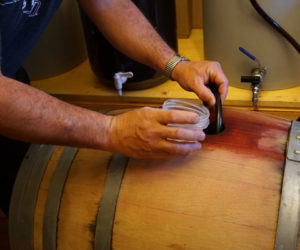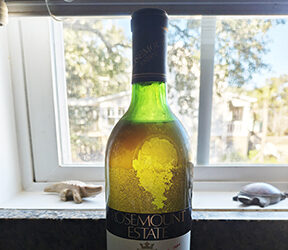Q
As a soon-to-be first-time winemaker, I need to know something about a topic no one talks much about before I start . . . water. I have a well and the water from it is great. But, it goes through a water softener, which adds sodium to the final product at the faucet. Is this OK, or should I be using water from a different source?
Jim Hartje
Otto, North Carolina
A
That is a wonderful question! It’s estimated that it takes anywhere from 2–10 gallons (8–38 L) of water to make a gallon (4 L) of wine. Most of that estimate is for sanitation but there’s no doubt a little bit gets mixed up in the wine when we rehydrate our yeast or dissolve tartaric acid. Sometimes we need to add a lot more to account for high sugar levels; depending on the yeast you use, it’s harder to ferment something to dryness over 25 °Brix.
Does the water you use in winemaking matter? I say yes indeed, especially for two important applications: Yeast rehydration and kit concentrate dilution. In the case of the former, you really need to make sure the water has absolutely no chlorine in it (which can inhibit sensitive yeast) and it does need to contain some trace minerals like magnesium, which helps support healthy yeast growth. In the case of the latter, you will be adding a large volume of said water to dilute the grape concentrate that comes in the kit so if you have terrible tasting water it could be reasoned it might adversely affect the taste of the final wine.
If you have to add a significant amount of water to your wine for any reason, the quality of water will definitely matter. Water in our homes typically comes from a municipal source (tap water) or from wells on our properties. The problem with tap water is that it usually contains chlorine, which needs to be filtered out with an activated charcoal or carbon filter before being used for winemaking. You can find these at hardware or water supply stores. The problem with well water, however, is not the chlorine but the potential bacteria, heavy metals and other contaminates. I recommend a 0.45 micron filter (using your pre-bottling wine filter would work) and an activated charcoal filter to remove impurities. If you really want to know what’s in your water, you might want to try filtering some of your well water and then sending it out to be plated for bacteria and for heavy metal analysis.
Water softeners add another wrinkle, namely because they tend to add a lot of sodium. This can help well water taste better but also can disturb yeast during the hydration process and wreak havoc with their cellular membranes. If you have a water softener I recommend bypassing it or turning it off so you’re not getting all the added salts.
Here are some pros and cons of types of water, and what to do for your unique situation:
Municipal/tap water:
Pros: Usually bacteria-free and has an acceptable taste.
Cons: Contains chlorine that can inhibit yeast, especially during the sensitive rehydration phase.
To Do: Pass through an activated charcoal/carbon filter.
Well water:
Pros: Can taste great, locally sourced.
Cons: May not taste good. Potential for bacteria and heavy metal or mineral contamination.
To do: Pass through an activated charcoal/carbon filter and 0.45 micron filter to remove any bacteria.
Softened water:
Pros: Acceptable taste.
Cons: High sodium content that can interfere with yeast and the “good” bacteria you want in winemaking.
To do: Bypass your water softening system and treat as per above depending whether it is well water or municipal water.
Distilled water:
Pros: No taste, no bacteria.
Cons: No minerals at all, which the yeast need in small amounts for healthy fermentation. It may be treated with chlorine.
To do: It is fine for rinsing labware, but not recommended for use in winemaking.
Bottled “spring” water:
Pros: Acceptable taste, low possibility of microbes.
Cons: May have been treated with chlorine, hard to know where it came from.
To do: Pass through an activated charcoal filter if there is a possibility it has chlorine.
Q
I picked up 500 lbs. (227 kg) of Syrah from Paso Robles, California. I was told the Brix was 26.2 at 52 °F (11 °C). After bringing the grapes home and cold soaking for two days, the Brix shot up to 30, per my hydrometer. Instead of adding water, I decided to ferment. I had a successful fermentation after seven days. I adjusted the pH, pressed and introduced malolactic bacteria. The wine is in a barrel and actually has some dark cherry tastes and it’s not bad. However, there is a medium-strong alcohol smell to the wine. My question is, how do I get rid of the alcohol smell at this point? The only idea I have is to blend the smell out by blending some Cabernet Sauvignon to the Syrah. Please help.
Ron Bas
Escondido, California
A
From personal experience I can tell you that red grapes from the warm (sometimes downright hot!) and dry region of Paso Robles always seem to “soak up” to a higher Brix then they sample in the field. For example, if I sample the vineyard the day before at 26.0 °Brix, I always assume that there are at least 1.5 °Brix units of what I’ll call “hidden sugar,” which will be released upon crushing and soaking up in the juice for 24 hours. This sugar gets sequestered in slightly dehydrated berries that are always in clusters once you get above 24 °Brix or so. Because of this, I always use this second Brix measurement when deciding if I will add water or not.
You took a big risk for a stuck fermentation by fermenting something at 30 °Brix with no water added to bring it down. Most yeast strains have a hard time fermenting above 16% alcohol (some even have a lower threshold) and if you assume a rough Brix-to-alcohol conversion rate of 0.58, then your initial 30 °Brix x 0.58 = 17.40% alcohol. No wonder you are smelling some extra ethyl alcohol aroma.
As far as removing the alcohol aroma goes, there is nothing you can do unless you blend the wine with some lower-alcohol product that you may have. Cabernet is a classic blender for Syrah and you may find that a blend yields very pleasing results.
Another option you could try, if you are a fan of dessert wines, is to turn this boozy batch into the base for a Port-style wine. Because home winemakers can literally play “mad scientist” and concoct all kinds of crazy beverages that commercial winemakers legally can’t, have some fun and try adding some sweetener and perhaps a little more alcohol. For the sweet side, how about trying seedless, strained blackberry jam or cherry concentrate to taste? For the extra alcohol, I would try to find a nice brandy that you like; you can just buy one off the shelf.
When I made the inaugural batch of Bonny Doon’s “Bouteille Call” Syrah/raspberry dessert wine, I shot for an alcohol of 18-19% and a residual sugar of about 20 g/L if I remember correctly. The important thing is to do bench trials, blend to a balance of sugar, tannin, alcohol and acidity and most importantly, to blend something you like. And don’t forget to water back your fermentation next time.
Q
I have a batch of white wine from grapes that I picked in heat, had crushed/ destemmed and bladder pressed. I took home juice in ice chests I have previously used (and cleaned) for several harvests. I transferred the juice to a 6.5-gallon (25-L) glass carboy as soon as I got home. I’m pretty careful about keeping it clean but I’m getting tiny bubbles that look like the wine is going through malolactic fermentation (MLF). I did not inoculate with lactic acid bacteria. My Brix is at -3 and I do not taste or smell Brettanomyces or any other funk but I worry I will. What bacteria can produce tiny bubbles in a dry must other than malolactic bacteria, and how concerned should I be that my wine is infected?
Tom DuKet
Topanga, California
A
There are so many microbes that can produce tiny bubbles in new wines that perhaps your question should be, what microbes will not produce tiny bubbles in dry must?
Everything from (of course) Lactobacilli (AKA LAB or lactic acid bacteria) to Acetobacter (which produce acetic acid) to spoilage yeasts like Brettanomyces will produce carbon dioxide gas as they go about their metabolic business. The very fact that these organisms can survive in a sugar-dry (no fermentable sugars left) environment means that they are at a special risk for stored and bottled wines. Before you finger one of these microbes, however, do be aware that lactic acid bacteria are generally present in the environment to some degree and even if you didn’t inoculate with them you may have a spontaneous malolactic fermentation happening in your wine. For this reason, unless you add sulfur dioxide immediately upon the halt of primary (sugar) fermentation, you may want to inoculate to make sure your malolactic fermentation goes to completion with the microbes of your choice. This way you know that there is no more residual malic acid and your wine will be much more stable during bulk aging (in barrel or carboy) and in the bottle.
You should also be aware that new wines, such as the one that you have described in your question, can retain quite a lot of dissolved carbon dioxide gas from the primary sugar fermentation. In fact, it’s common for new wines to continue degassing for the first few months of their lives, especially when stored in cold temperatures (this is because cold encourages the storage of dissolved gas in the liquid phase). Often, after winter when the weather warms up, winemakers experience popped bungs, tiny bubbles and other releases of gas that may come from “stored” dissolved carbon dioxide.
If you know primary and secondary (MLF) fermentations are complete you can encourage the release of this naturally occurring fizz by racking your wine, or moving it from one container to another. Racking is especially important if you had a troubled primary fermentation or otherwise want to get your new wine off of the lees (the fermentative sediment) so it won’t impart off-flavors or aromas. This movement of wine from container to container will help to drive off some of the accumulated carbon dioxide and should leave you with a more still product.
If you detect increased bubble release after that, and you know that your wine is ML complete then I would start to worry that you have some kind of an infection. At that point you may want to increase your sulfur dioxide levels to over 30 ppm free SO2 and be sure to keep an eye on the wine’s development. If you suspect you have a problem, and you still want to bottle the wine (i.e. you like how it tastes and smells) then I recommend passing the wine through a 0.45 micron filter before bottling.






